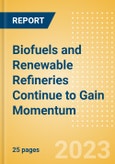The five biofuels that are most prevalent within the current market are ethanol, FAME biodiesel, renewable diesel, biomethanol, and sustainable aviation fuels (SAFs). These fuels are generated through the processing of biomass. Each biofuel contains a number of advantages and disadvantages. However, most key is that biofuels produce less carbon emissions over their lifetime than conventional fuels and so offer decarbonization potential to industries that are unsuitable for electrification. The decarbonization potential of biofuels has led to their increasing demand and growing policy support, leading many refiners to consider diversifying their products to renewable fuels. Options for refiners include co-processing, conversion of conventional refineries to renewable refineries, and standalone renewable refinery projects. Converting existing refineries offers potential cost savings compared to building new refinery facilities. However, there are a number of challenges that accompany conversion. The economic viability of refinery conversion will hinge on factors such as feedstock proximity, availability and price as well as the degree to which legacy equipment can be retrofitted for renewable fuels.
Key Highlights
- SAFs are expected to overtake FAME Biodiesel in 2037 and will grow at a CAGR of 32% between 2022 and 2040. This strong growth will be facilitated by policies aimed at decarbonizing the aviation sector such as the Refuel EU Aviation Initiative.
- Ethanol will show a more gradual increase of 1.8% over the same time frame which reflects some of this fuel's drawbacks such as its use of edible crops and comparatively lower energy content than conventional fuels, which increases fuel consumption and overall running costs.
- The number of companies mentioning biofuels within their company filings has been increasing, with the number of filer companies increasing at a CAGR of 14% between 2016 and 2022.
- Neste Corp recorded the highest number of mentions of biofuels within its filings since 2020, recording 134 across this time frame.
- The number of global renewable refineries is expected to reach 187 in 2030, compared to 42 in 2020.
- The United States will remain the dominant player in terms of production, accounting for 45% of renewable fuel production capacity in 2030.
- Only 8% of upcoming projects are crude refinery conversions, reflecting the challenges of repurposing oil refining infrastructure for the production of biofuels
Scope
- Assessment of conventional biofuels within the current market and their limiting factors
- Key market players with respect to each biofuel
- Upcoming biofuels policies
- Biofuel deals and company filings data
- Renewable fuel consumption and production forecasts
- Geography of active and upcoming renewable refinery projects
- The current renewable refinery conversion trend and its challenges
- Leading companies that are converting crude oil refineries
Reasons to Buy
- Obtain the most up to date information on recent developments and policies related to the oil refinery conversion trend.
- Identify the opportunities of challenges associated with the switch form oil refining to renewable refineries.
- Assess competitors based on their active and pipeline capacities for renewable fuel production and gain an overview of largest upcoming renewable refinery project.
- Develop business strategies by identifying the most promising route to renewable fuel conversion.
Table of Contents
- Executive Summary
- Biofuels Briefing
- Introducing our five focus biofuels
- Advantages and disadvantages of biofuels
- Key players in the biofuels market
- Biofuel policies driving increasing consumption
- Biofuels Market Outlook
- Biofuel consumption trends
- Biofuel deal activity
- Biofuel filing trends
- Renewable Refineries Outlook
- Production capacity outlook
- Renewable fuels market landscape
- Largest active and upcoming renewable refineries
- Renewable refinery projects by type
- The switch to renewable refineries
- Oil and gas sector strategies amid the rise of renewable fuels
- Advantages and disadvantages of refinery conversion
- Active and upcoming conversion projects
- Top companies converting refineries
- Standalone vs conversion projects
- Key players in the biofuels market
- Biofuels main policies, strategies, and targets
- Crude refineries conversion and co-processing: active and upcoming projects
- Renewable fuel consumption, 2022-2040
- Ethanol consumption, 2022-2040
- Biofuel deal activity
- Number of companies mentioning ‘biofuels’ within their filings, 2016-July 2023
- Top ten filer companies for mentions of ‘biofuels’, Jan 2020 - July 2023
- Renewable fuel production capacity and projects, 2020 - 2030
- Renewable refinery capacity by country, 2020
- Renewable refinery capacity by country, 2030
- World’s largest renewable refinery projects by capacity in 2030
- Current renewable refinery projects by stage of development
- Upcoming renewable refineries by type
- Top companies retrofitting crude oil refineries capacity
- Renewable refineries: converted and co-processing vs standalone
Companies Mentioned (Partial List)
A selection of companies mentioned in this report includes, but is not limited to:
- Aventine renewable energy Inc
- POET LLC
- Valero Energy Corp
- Green Plains Renewable Energy Inc
- Cerradinho Bioenergia S.A
- Renewable Energy Group
- Ag Processing Inc
- Cargill Inc
- World Energy LLC
- ADM Ltd
- Neste Corp
- Diamond Green Diesel LLC
- UPM Corp
- Eni SpA
- TotalEnergies SE
- Moller-Maersk AS
- MOL
- Waterfront Shipping Ltd
- Marinvest
- Gevo
- SkyNRG
- Alder Fuels
- FutureFuel Corp
- Darling Ingredients Inc
- Bangchak Corporation PCL
- TotalEnergies
- Borregaard ASA
- Amentis Inc
- Suncor Energy Inc
- Repsol SA
- Marathon Petroleum Corp
- PT Pertamina
- Exxon Mobil Corp
- Cresta Fund Management LLC
- Shell plc
- Global Clean Energy Holdings Inc
- Corral Petroleum Holdings AB
- BP Plc
- HF Sinclair Corp
- Preem AB
- Imperial Oil Ltd
- PBF Energy Inc
- Phillips66
- North Atlantic Refining Ltd.








